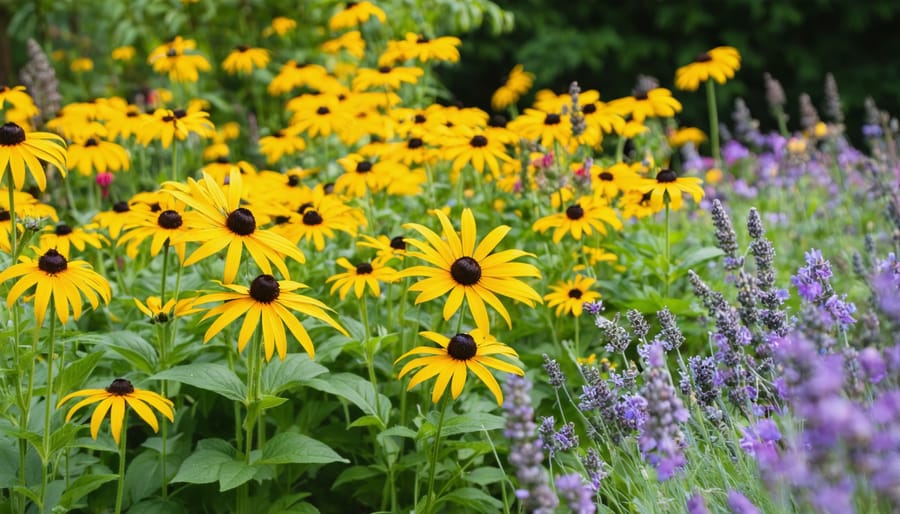Transform your garden into a summer-long flower show by planting continuous bloomers in strategic waves – early summer perennials like salvias and coneflowers, followed by mid-season black-eyed susans and phlox, and late-season asters and sedums. Deadhead spent blooms every 3-4 days, snipping just above the nearest leaf node to stimulate new flower production and redirect the plant’s energy toward fresh growth. Feed flowering plants with a balanced, phosphorus-rich fertilizer every two weeks during peak growing season, applying in the early morning or late evening to maximize nutrient absorption. Create optimal growing conditions by mulching beds with 2-3 inches of organic material to retain moisture, suppress weeds, and maintain consistent soil temperatures that flowering plants crave. Master these essential techniques, and you’ll enjoy waves of vibrant blooms from June through September, turning your garden into a continuous display of color and life that attracts pollinators and admirers alike.
Smart Planning for Continuous Blooms
Selecting Succession Bloomers
Creating a garden that blooms continuously throughout summer requires careful selection of plants with different flowering periods. Think of it as orchestrating a beautiful symphony where various stunning summer flowers take center stage at different times.
Start by choosing early summer bloomers like peonies and delphiniums for June color. Follow these with mid-summer stars such as black-eyed susans, bee balm, and purple coneflowers that peak in July. For late summer, incorporate dahlias, Russian sage, and Japanese anemones that will carry your garden into fall.
When selecting plants, pay attention to their bloom times listed on plant tags or catalogs. Create a simple spreadsheet or garden journal to track when different plants flower, helping you identify and fill any gaps in your summer display. Mix perennials with long-blooming annuals like zinnias and cosmos to ensure consistent color.
Consider including at least three different plants for each blooming period in your garden. This approach not only maintains continuous color but also provides backup if some plants underperform. Remember to choose varieties suited to your growing zone and garden conditions – healthy plants are more likely to flower abundantly and for longer periods.

Creating Bloom Time Charts
Creating a bloom time chart is your secret weapon for maintaining a vibrant garden throughout summer. Think of it as your garden’s personal calendar, helping you orchestrate a continuous display of colors and textures. Start by listing all your existing plants and researching their typical flowering periods. Include versatile options like daylilies for continuous blooming, which can provide reliable color for weeks.
Create a simple spreadsheet or garden journal divided into early, mid, and late summer columns. Mark when each plant typically starts and stops blooming, using different colors to represent various flower shades. This visual guide helps identify any gaps in your flowering schedule that need filling.
Pro tip: Include bloom duration alongside each plant entry. Some flowers might look spectacular but only last a week, while others provide steady color for months. Aim to have at least three different plants blooming in each period, ensuring overlap between flowering times.
Consider factors like sunlight patterns and plant heights when plotting your chart. Tall, late-blooming plants shouldn’t overshadow earlier bloomers. Update your chart annually, noting which combinations worked well and which areas need adjustment. This living document becomes more valuable each season, helping you fine-tune your garden’s performance and maintain that coveted continuous display of summer color.
Essential Care Techniques
Strategic Deadheading
Deadheading is your secret weapon for keeping those beautiful blooms coming all summer long. This simple yet effective technique involves removing spent flowers before they go to seed, redirecting your plant’s energy into producing new blooms instead of forming seeds.
The best time to deadhead is early morning or evening when plants are less stressed. Look for flowers that have started to fade or turn brown, and using clean, sharp pruning shears, snip the stem just above the first set of healthy leaves below the spent bloom. For plants with multiple flowers on a single stem, like salvias or delphiniums, cut back the entire flowering stem once most blooms have faded.
Some plants, like geraniums and marigolds, can be deadheaded by simply pinching off the spent blooms with your fingers. However, tougher stems on plants like roses or zinnias require pruning shears for a clean cut that prevents damage and disease.
Make deadheading a regular part of your garden routine – a quick 10-minute session every few days is more manageable than waiting until your garden is overwhelmed with spent blooms. Pay special attention to self-seeding flowers like cosmos and black-eyed susans, as these enthusiastic bloomers will stop producing flowers if allowed to go to seed.
Remember to leave some late-season blooms to develop seeds if you want to attract birds or collect seeds for next year’s garden.

Feeding for Flowers
Just like us, flowers need proper nutrition to maintain their vibrant blooms throughout summer. The key to continuous flowering lies in providing the right nutrients at the right time. Start with a balanced, slow-release fertilizer in early spring when plants begin showing new growth. Look for a formula with a higher middle number (phosphorus), such as 5-10-5, as phosphorus promotes blooming.
During the peak growing season, feed your flowering plants every two weeks with a water-soluble fertilizer. I’ve found that organic options like fish emulsion or compost tea work wonderfully and support soil health too. Remember to dilute these according to package instructions – more isn’t always better!
For an extra bloom boost, supplement with a phosphorus-rich fertilizer when you notice flower production slowing down. Many experienced gardeners swear by banana peels buried near plant roots for a natural potassium boost, which helps with flower development.
Always water your plants thoroughly before fertilizing to prevent root burn. Apply fertilizer in the early morning or late afternoon, avoiding the hot midday sun. If you’re growing flowers in containers, they’ll need more frequent feeding – about once a week – since nutrients wash out more quickly.
Watch your plants for signs they need feeding: pale leaves, weak stems, or reduced flowering are all indicators it’s time for a nutrient boost. Just be careful not to overfeed, as this can lead to lots of foliage but fewer flowers.
Water Management
Proper watering is the key to keeping your flowers blooming throughout summer. While it might seem straightforward, effective water management strategies can make the difference between sporadic blooms and a garden that flourishes all season long.
Water deeply but less frequently to encourage strong root development. This means providing about 1-2 inches of water per week, depending on your climate and soil type. Early morning watering is ideal, allowing plants to absorb moisture before the heat of the day while reducing the risk of fungal diseases.
Focus on watering the soil around your plants rather than spraying the foliage. Using a soaker hose or drip irrigation system helps deliver water directly to the roots where it’s needed most. Add a 2-3 inch layer of mulch around your flowers to retain moisture and keep roots cool during hot summer days.
Pay attention to signs of water stress: wilting leaves during the day that don’t perk up in the evening, or flowers dropping prematurely often indicate insufficient water. Conversely, yellowing leaves and mushy stems might signal overwatering. Check soil moisture by inserting your finger about 2 inches deep – if it feels dry at that depth, it’s time to water.
Remember that different flowers have varying water needs. Group plants with similar water requirements together to make maintenance easier and more efficient.
Problem-Solving and Prevention
Weather Challenges
Summer weather can present various challenges for keeping your flowers blooming, but with the right protective measures, your garden can thrive even during extreme conditions. High temperatures, intense sunlight, and unexpected storms are the main obstacles you’ll need to navigate.
During heat waves, provide extra shade for sensitive flowers using shade cloth or umbrellas. Set these up during the hottest part of the day, typically between 10 AM and 4 PM. Installing a misting system can help cool the air around your plants and maintain humidity levels. Remember to water deeply in the early morning or evening to prevent water evaporation and plant stress.
Strong winds and storms can damage delicate blooms and stems. Consider installing temporary windbreaks or barriers around flower beds during stormy weather. Stakes and plant supports should be secured firmly in the ground before bad weather hits. For container gardens, move pots to sheltered locations when severe weather is forecast.
Unexpected cold snaps can occur even in summer. Keep frost protection materials like row covers or old bedsheets handy. These can be quickly draped over flowers when temperatures drop unexpectedly. For potted plants, moving them closer to your house or under a covered porch provides additional warmth.
Heavy rain can lead to soil erosion and fungal problems. Improve drainage by adding organic matter to your soil and maintaining proper spacing between plants to promote air circulation. Consider installing rain barriers or temporary covers during periods of excessive rainfall to protect delicate blooms.
Mulching is your best friend in managing weather extremes. A 2-3 inch layer of organic mulch helps regulate soil temperature, retain moisture during hot spells, and protect roots from temperature fluctuations. Just remember to keep mulch away from plant stems to prevent rot.
Pest and Disease Management
Keeping your flowers blooming all summer requires vigilant monitoring and swift action against pests and diseases. Regular inspection of your plants, particularly the leaves and stems, can help you catch problems early before they become severe. Look for common signs like yellowing leaves, spots, wilting, or unusual growth patterns.
Some of the most frequent garden pests include aphids, spider mites, and Japanese beetles. These unwanted visitors can quickly multiply and damage your flowering plants if left unchecked. Implementing natural pest control methods such as introducing beneficial insects like ladybugs and praying mantises can help maintain a healthy balance in your garden.
For disease prevention, proper air circulation is crucial. Space your plants appropriately and remove any debris or dead foliage that could harbor fungal spores. Powdery mildew, a common summer problem, can be prevented by watering at the base of plants and avoiding wet foliage, especially in the evening.
If you notice black spots on leaves or stems showing signs of rot, remove affected parts immediately to prevent spread. A solution of one part milk to nine parts water, sprayed on leaves weekly, can help prevent fungal issues naturally. For pest infestations, a simple solution of mild dish soap and water can deter many common insects without harming beneficial ones.
Remember to check your plants’ overall health regularly – stressed plants are more susceptible to both pests and diseases. Maintaining proper watering schedules and ensuring adequate nutrition will help your flowers naturally resist many common garden problems.

Quick-Fix Solutions
When you notice gaps in your summer blooms, don’t worry – there are several quick solutions to keep your garden bursting with color. One of the fastest fixes is to add instant-color annuals like marigolds, zinnias, or petunias to fill empty spaces. These flowers establish quickly and provide immediate impact.
Deadheading is your best friend for maintaining continuous blooms. Spend just 5-10 minutes each morning removing spent flowers to encourage new ones. Pay special attention to repeat bloomers like salvias and black-eyed susans – they’ll reward you with fresh flowers within days.
For areas that need a boost, try the “Chelsea chop” technique: cut back one-third of your late-summer perennials by half their height in late spring. This creates a second wave of blooms just when your garden might be looking tired. Works wonders with phlox and sedums!
Keep a few container gardens ready as mobile color spots. When one area starts fading, simply move a blooming container there to maintain visual interest. Mix fast-growing flowers like cosmos and calendula in these pots for reliable color.
A quick dose of bloom-boosting fertilizer (high in phosphorus) can jumpstart flowering within a week. Apply it in the evening and water thoroughly. For organic gardens, try a foliar spray of compost tea – it works almost as quickly.
Remember to water deeply during dry spells, focusing on the root zone. Stressed plants stop blooming, but they’ll bounce back within days of proper watering. Adding a 2-inch layer of mulch helps retain moisture and reduces stress on your flowering plants.
With these proven strategies at your disposal, you’re well-equipped to enjoy a garden filled with continuous blooms throughout the summer season. Remember that successful flower maintenance comes down to consistent care, proper planning, and attention to detail. By deadheading regularly, providing adequate water and nutrients, and selecting a diverse mix of plants with different blooming periods, you’ll create a vibrant display that lasts for months. Don’t forget to monitor your garden daily for early signs of problems and adjust your care routine as needed. Whether you’re growing flowers in beds, containers, or both, these techniques will help you achieve the long-lasting color and beauty you desire. Start implementing these practices today, and watch your garden transform into a summer-long showcase of gorgeous blooms that will delight both you and your visitors.




